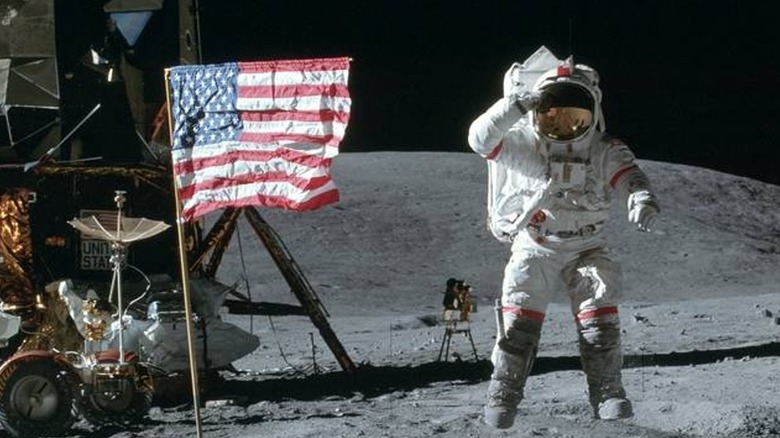How NASA's Space Suits Have Had To Adapt Over Time
Space suits are more complex than people think — they are, in fact, a small spacecraft, NASA explains. Just like a typical spacecraft, space suits have to provide vital life support systems, endure the harsh environment of space, and protect astronauts from radiation and extreme temperatures. These suits also have to be flexible enough for astronauts to work and live in.
In August 2021, NASA was hit with a scandal after an audit report from the Office of the Inspector General revealed the Artemis mission space suits would cost $1 billion dollars. The space agency, which says its next-generation space suits will have major upgrades, plans on using them for the next era of space exploration, the return of humanity to the moon, and establishing a permanent base in the lunar south pole. The Artemis space suit modifications include dust-tolerance features for support systems, advanced mobility, and a new inside-helmet communication system (via NASA).
Space suits have come a long way since the first NASA missions, having adapted over time as missions became more complex.
The first space suits
In a post on its website, NASA looks back to the first space suits used in the Mercury missions from 1959 to 1963, explaining they were designed for a crew that never had to leave the spacecraft. The suits were very basic and inspired by pressure suits used by pilots in high-altitude aircraft. They protected astronauts and technology in the early stages of space flights.
The 1965 and 1966 Gemini missions followed, bringing about a major change that forced a redesign of the suits: astronauts would, for the first time, step out into the void of space for a spacewalk. Still, Gemini suits were not as complex as the ones that followed and they lacked a built-in life support system. NASA explains that a hose connected the suit to the spacecraft when necessary to supply the astronaut with oxygen.
The suits used for the Apollo program flights in the late '60s and early '70s had to do much more than the ones used in Gemini, according to NASA, as they were created to support life on the moon. Unlike the previous iterations, these suits had an integrated life support system that allowed astronauts to walk untethered. While the moon space suits were rather bulky, they were also flexible, and, to top things off, the space agency even threw in a pair of boots specially designed to walk on the lunar surface.
How the Shuttle era defined modern and future space suits
The Space Shuttle program defined modern space suits. During take-off, landing, and while inside the Shuttle, astronauts wore NASA's iconic orange suits. When the time came for spacewalks, they changed into the classic heavy white space suits that are so well known today. These heavy white suits are the same ones NASA astronauts use today on the International Space Station. They come with cool accessories, like the nitrogen-propelled, hand-controlled Manned Maneuvering Unit, which is a type of seat with small thrusters that allows astronauts to navigate in open space (via NASA).
But NASA faced a major suit challenge during the Shuttle era. The agency used to tailor and customize each suit, taking into consideration the astronaut's height, weight, and other measurements. The Space Shuttle Program, on the other hand, flew 135 missions and took 355 astronauts to space, as reported by Space.com. Using a single suit for each astronaut became an impossibly expensive approach.
To get through this problem NASA created a "plug-n-play" suit. Former astronaut Bonnie Dunbar explains that by combining different parts, 18 suits were built for hundreds of astronauts. Helmets came in one size, but Hard Upper Torso units came in five different sizes, and arm and leg lengths could be adjusted but only came in two diameter options. Astronauts could also choose from two sizes of boots and customized gloves.
"Not all selected and trained [Shuttle] astronauts could fit into or function in the suit, and many crewmembers experienced shoulder injuries, pressure points, fingernail loss, and nearly a 50% loss of effective strength due to the pressure resistance of the suit," Dunbar reveals.
Dunbar is now focused on developing 3D spacesuit printing technology. On February 25, 2022, NASA selected her project for development through the Innovative Advanced Concepts (NIAC) Program. She believes that in the future, astronauts living on Mars, or traveling on long deep space journeys, will step into a 3D scanner and have a customized, sleek, and effective 3D suit printed out.


